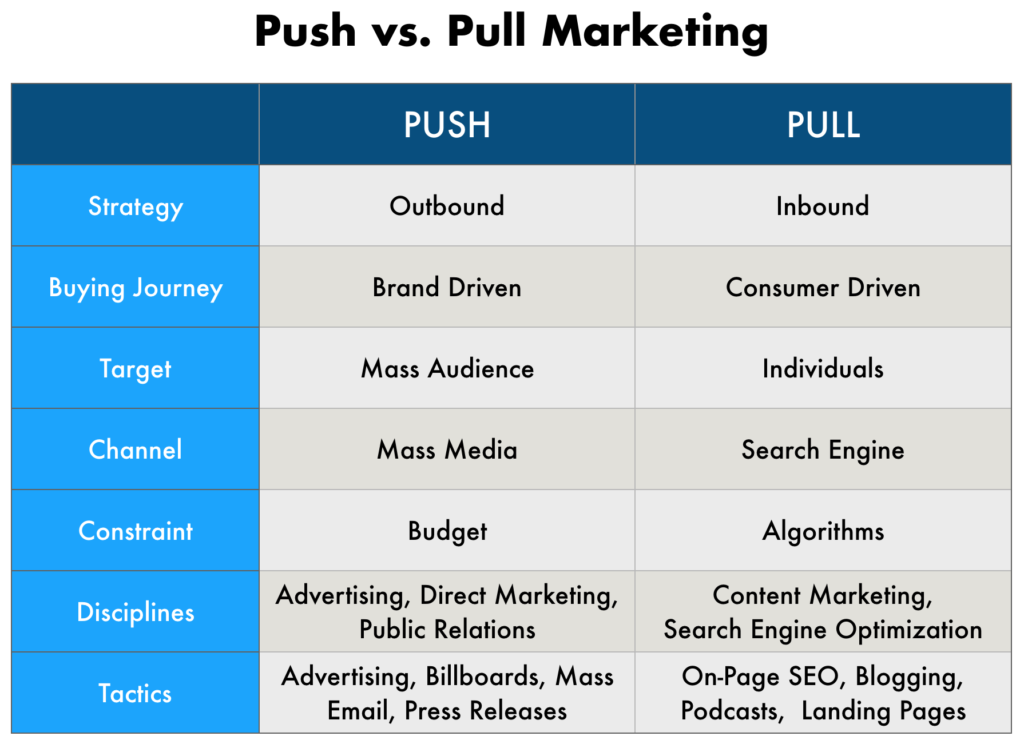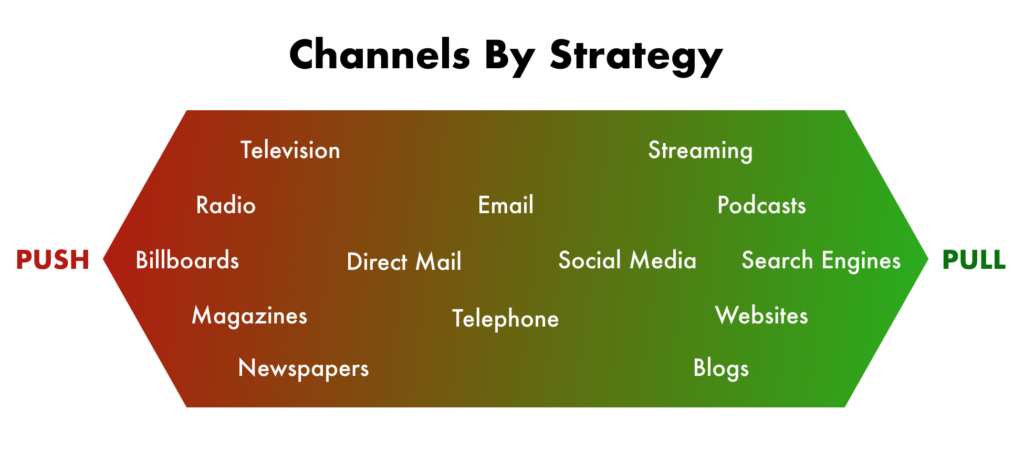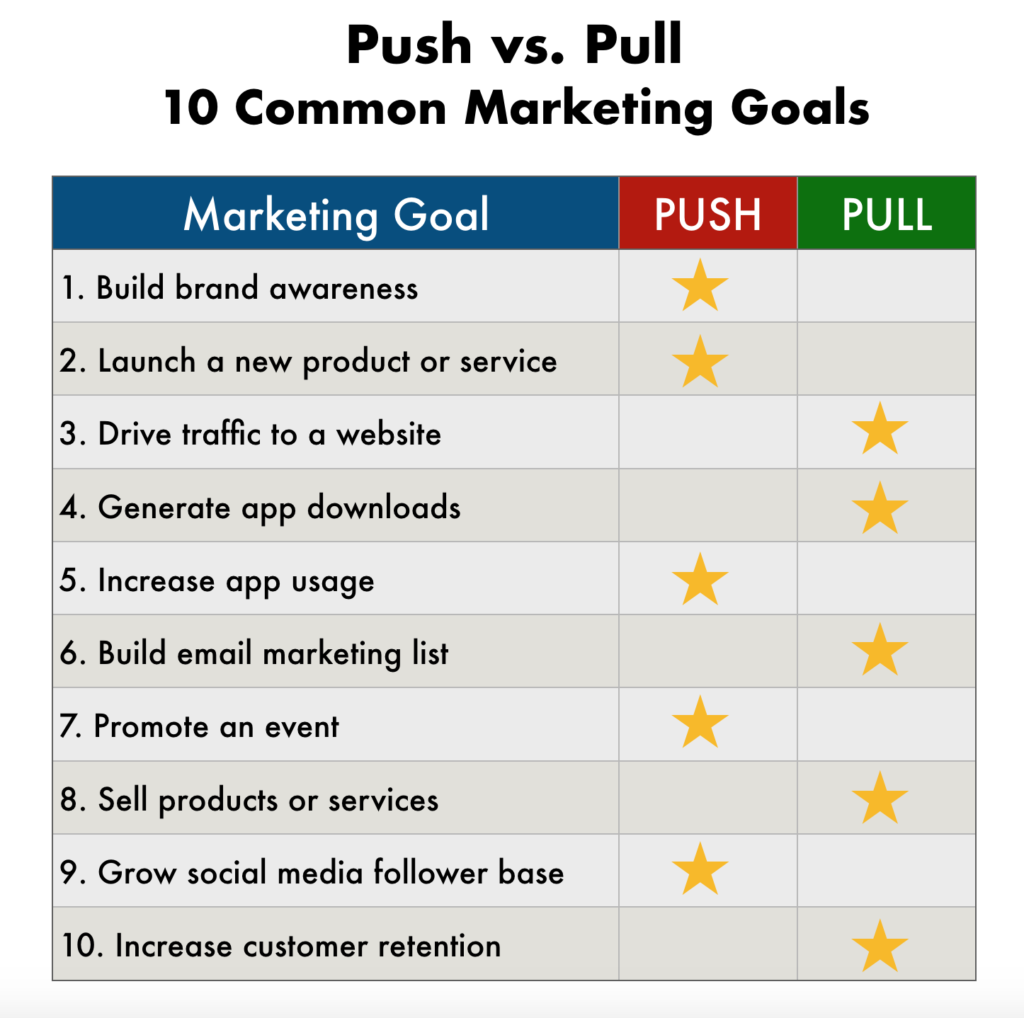TLDR:
- Marketing tactics can be assessed under the framework of Push versus Pull.
- Before the Internet came around and changed everything, marketers enjoyed a powerful position in the buyer’s journey.
- With the emergence of Search Engines, the balance of power shifted from brands to consumers, creating the need for Pull Marketing techniques.
- Push marketing strategies focus on getting the brand message in front of as many people as possible, as frequently as possible.
- Pull marketing strategies occur when the consumer is in control of the marketing material and advertisements they choose to consume.
- Large brands employ a mix of push and pull tactics.
- Marketing budgets are the limiting factor when it comes to selecting marketing tactics.
- Push channels such as Television, Radio, and Billboards require large advertising budgets.
- There is no one-size-fits-all approach to developing the ideal Push versus Pull mix.
- Brands must consider their campaign goals, target audience, and budget constraints when developing their unique mix of Push and Pull tactics.
“People don’t like to be sold, but they love to buy.” Jeffrey Gitomer
It is easy to over-complicate marketing strategies due to the vast array of tactics available to businesses of all sizes. However, all marketing tactics can be assessed under the simple framework of Push versus Pull. The process of determining the need for push versus pull tactics in a given situation leads to more efficient use of funds to reach a specific goal. We will first explore the origin of Push versus Pull, define tactics and advertising channels, then, finally, apply this knowledge to the cryptocurrency industry.
The Internet’s Effect on Buyer Behavior
Before the Internet came around and changed everything, marketers enjoyed a powerful position in the buyer’s journey. Mass advertising, sales people, and brick & mortar businesses held all the cards when it came to information needed to make a buying decision. Consumers could consult their friends and neighbors for recommendations on a particular product, but, beyond that, brands controlled most of the information needed to make a calculated buying decision.
“Traditional marketing is often synonymous with push marketing. This marketing strategy casts a wide net in the hopes of grabbing as many potential customers as possible.” MarketingSchools.org
The Buyer’s Journey
Marketers developed the Buyer’s Journey concept to assist in managing the flow of prospects from shopping to purchase. This classic concept had been at the core of advertising theory long before the Internet modified consumer behavior and created the need for Pull tactics.
The buyer’s journey consists of three stages:
- Awareness – consumer realizes they have a need that a purchase will fill
- Consideration – consumer defines their need and options for resolving it
- Decision – consumer selects an option
Awareness is all about getting a certain message in front of consumers, making mass advertising a natural fit. Decision typically involves the brand to some degree – the consumer must enter a store or contact a supplier to complete their purchase.
Consideration, however, has been completely redefined since the emergence of Search Engines. The balance of power shifted from brands to consumers, leading to the creation of new marketing disciplines such as Search Engine Optimization, Content Marketing, and Social Media Marketing. Pull techniques are synonymous with the emergence of search engines.
“The Internet and its various tools of information discovery have forever changed the buyer’s journey, giving more control to the buyer and siphoning much of it away from salespeople.” Russell Glass
Defining Push and Pull Marketing Strategies
Push versus Pull marketing is best understood from the point of view of the consumer.
Push marketing strategies focus on getting the brand message in front of as many people as possible, as frequently as possible, to create awareness around a brand and its product/service offering. Examples of push tactics include billboards and television advertisements. As a consumer in the vicinity of these push campaigns, it is impossible to avoid seeing the billboard or television ad. Push ads are ubiquitous… they are everywhere, “pushing” their message to the public. The brand is in charge.
Pull marketing strategies, on the other hand, occur when the consumer is in control of the marketing material and advertisements they choose to consume. For example, someone looking to purchase a car will likely consult a search engine for information before stepping into a car dealership. Without the need of a salesman, the consumer can assess vehicle specifications, safety ratings, re-sale cost and more using search engine queries. The consumer is “pulling” information in order to make a buying decision. The consumer is in charge.
Both Push and Pull marketing tactics have a place in the marketing plan.
Running both types of strategies at once can produce impressive results. Large brands regularly employ a mix of Push and Pull tactics ranging from television advertising and press releases to informative (and free) content readily available online. The following table clarifies the dual existence of Push and Pull strategies utilized by well-developed brands.
Budgets Determine Tactics
Marketing budgets are the primary limiting factor when it comes to selecting marketing tactics. Push tactics are usually more expensive than Pull tactics, and the results of Push campaigns cease when the campaign/budget ends. Pull tactics, however, tend to focus on building search engine visibility and yielding long-term results.
The cost of Push and Pull marketing tactics becomes clear when considered within the scope of the communications channels themselves:
Push channels such as Television, Radio, and Billboards require large advertising budgets. Pull channels such as Search Engines, Podcasts, and Blogs require content creation and website optimization. Budget needs will tend to be larger at the outset for push channels, while pull channels provide opportunities for significant visibility at low cost (if the brand’s content is compelling enough to win the attention of consumers).
Small budgets make most push marketing tactics ineffective due to lack of ad frequency and optimized scheduling. This is where digital marketing channels such as Search Engines and Social Media become attractive opportunities to maximize marketing ROI.
Choosing the Right Tactic
Now, let’s answer every marketer’s burning question: Where do I put my budget?
Begin by determining the immediate goal of the campaign in question. Typical campaign goals include building brand awareness, launching a new product, or driving traffic to a website. The following table provides ten common marketing campaign goals as well as their suitability for either Push or Pull tactics:
Applying Push and Pull Strategies to the Cryptocurrency Industry
Now let’s apply these marketing concepts to cryptocurrency brands. Clearly, buying cryptocurrency is not the same experience as buying coffee, or buying a car, for that matter. Cryptocurrencies are in their infancy when it comes to mass adoption, making the awareness stage of the buyer’s journey more heavily weighted than the consideration and decision stages. Simply put, there are far more people who are unaware of cryptocurrencies than there are cryptocurrency enthusiasts.
So, what is the cryptocurrency project to do? Traditional marketing strategy calls for push tactics such as television, radio, and billboard advertising to get the word out. But, in the realm of disruptive technologies, awareness is not always enough to get the consumer to consider purchasing your product. Imagine spending the entire budget on push tactics, only to find that mass audiences don’t want your product or service.
One alternative is to target niche audiences that already display a desire to acquire and use cryptocurrencies. Influencer marketing has been a popular tactic on this front, but has some pitfalls. Unfortunately, the niche market pool is relatively small and is already saturated with cryptocurrency projects vying for attention.
Create the Right Mix
“Push marketing has its place, but it is infinitely more valuable when paired with a firm foundation of pull marketing strategy.” Pia Silva
Answer the following questions in order to determine where a marketing budget should go:
- What is the immediate goal of the campaign?
- What is the budget?
- Has the project already maximized its organic exposure?
- Which user personas are most likely to help achieve the campaign goal?
- How quickly do results need to be seen?
It is important to note that there is no one-size-fits-all approach to developing the ideal Push versus Pull mix. Please send your feedback and questions to me via Twitter, and watch for future blog posts focused on specific cryptocurrency campaign goals with tactical recommendations.


